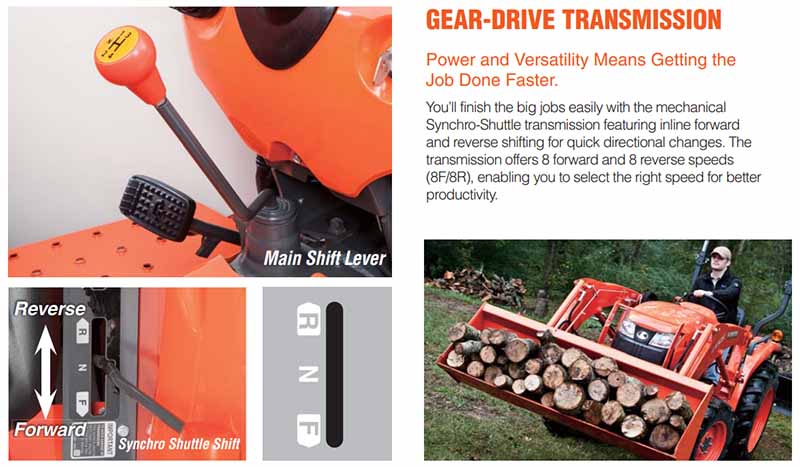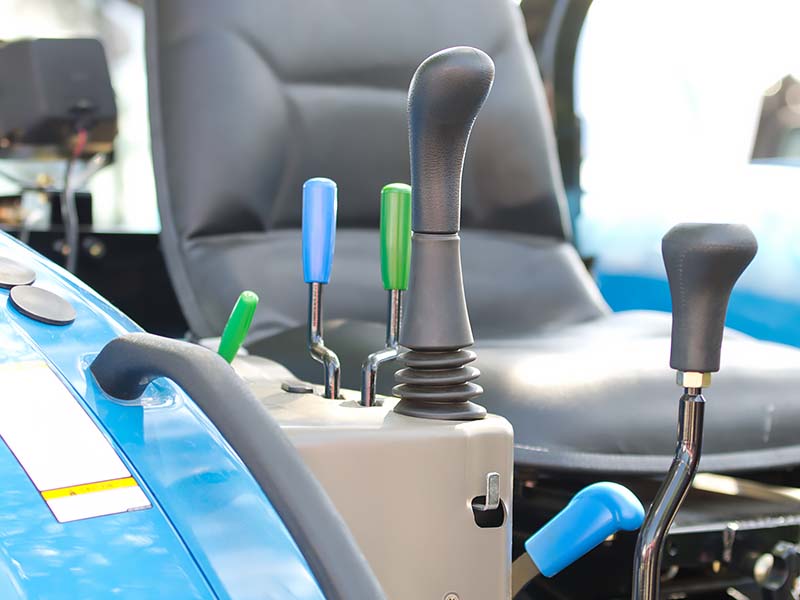The history of tractors and farm equipment is a testament to the ingenuity of this growing nation, the farming community, and the drive to produce viable crops and herds. It is the ingenuity and evolution of tractors that brings us to this blog. Back in the day, it was a plow and a mule or a team. The options were basically to stop or go and the brunt of growing crops took its toll on both the farmer and their tools.
Today, the going is a bit easier as tractors have evolved to include options that a farmer can choose to create a tractor that fits their land and crop plan, and that is kinder to the environment, the farmer, and does not require animals. Let’s discuss the different types of tractor transmissions so that farmers can make an informed decision about what type of transmission they need for their farm, land, and growing ambition.
Tractor Transmission Types
Because tractors are not just for farmers – landscaping, residential uses, etc. – they need to come with the options that outfit them for their working life. That includes having options for transmissions. The different types of transmissions available for tractors are as follows.
| Different Tractor Transmission Types and Uses | ||
| Transmission type | Action | Usage |
| Gear-Driven Transmissions | Locks to one speed | Sloped land and rough terrain |
| Power Shuttle Transmission | Clutch-less shifting | Drawbars and Loaders |
| Hydrostatic Transmission | Works like an automatic transmission on a car | Loaders or other tasks where constant speed is not required. |
| Continuously Variable Transmission (CVT) | A mix of electronic and manual transmissions | Useful for most applications where locked in speed is not required. |
Gear Drive Transmissions
Gear drive tractors come in a variety of mechanical and electronic designs. Those include:
Collar Shift
One of the most reliable types of gear-drive transmissions. They operate with a collar and fork that sets between the teeth on the gear. This option helps physically add strength to the transmission while under stress such as holding the tractor at a specific speed on a slope. The metal fork in the metal gear makes this a durable option.
Power Shift
A power shift transmission is a clutch-less transmission that uses a clutch pack rather than collars. It is smooth with push-button or level shifting. It works well to hold a tractor at a specific speed without having to depress the clutch. A good option if you need to run at variable speeds but still require holding at a consistent speed or where you have a lot of forward and backward motion.
Synchro Shift
A collar shift transmission at its core, but utilizes a synchronizer as a braking system that holds the speed of the gears at a consistent rate while shifting. A good option when you need a quieter mode of operation and for anyone who grinds the gears.
Sliding Gear
A sliding gear transmission uses a gear fork that positions the gears. As one of the least expensive options, it can be a good option if you are trying to save the final cost of a tractor, but it is the most difficult gear-drive transmission to use. It also has the least consistency of speed when you are trying to hold the tractor at a specific speed.
Gear Drive Advantages and Disadvantages
| Pros and Cons of Gear-drive Transmissions | |
| Pros | Cons |
| Remarkable for holding a tractor at a set speed | Not all variation are smooth and unless you are used to them the ride can be jerky |
| Most are durable | Simple in design so not a lot of options |
| Outstanding on slopes and rugged terrain | |
| Pairs well with attachments that work best at a steady rate of speed | |
| Collar Shift – Reliable | Expensive |
| Power Shift – Push button shifting for those who cannot or do not use a clutch | |
| Synchro – quiet, smooth, and steady speed | |
| Sliding Gear – Manual operation | Tricky to use, not as great of speed control, not a great choice for someone new to tractors. |

What Kubota says about their gear drive transmissions in the L3301 and L3901 models.
Shuttle Shift Transmissions
What Is Shuttle Shift on a Tractor? A shuttle shift or power shift transmission uses electronics to operate clutches within the transmission. Without having to depress a clutch, you can go forward and backward with less hassle. These are a little smoother than a power shift gear-driven transmission. They feature high and low ranges with 1–4 gears generally with a column shifter.
Shuttle Shift Advantages and Disadvantages
| Pros and Cons of a Shuttle Shift Transmission | |
| Pros | Cons |
| Hi-low gearing | |
| Column shifting so reverse is easy to find | Requires hand movement to shift |
| Can match backward speed with forward speed | |
| Perfect for small areas where maneuverability requires forward and backward motion – Chicken houses, small areas, | |
| More parts to maintain | |
| Works well with drawbar and loader attachments | |
Hydrostatic Transmission
How Does a Hydrostatic Transmission Work?
A hydrostatic transmission is an automatic transmission tractor drivers love. They work by forcing hydraulic fluid to the axils which then propel the wheels.
Hydrostatic Advantages and Disadvantages
| Hydrostatic Advantages and Disadvantages | |
| Pros | Cons |
| Smooth Ride | Must be professionally serviced |
| Perfect for loaders | Less efficient than gear-drives at converting HP to PTO. |
| Perfect for work that is not speed controlled related | Limits certain types of attachments that require higher HP at the PTO |
| Improved Speed Control when needed including automated cruise control | Can be more expensive over other transmission types. |
| Works like an automatic transmission on cars | |
| A good option for people new to tractors | |
| Electronic Hydrostatic transmission for advanced usage and pairing with certain attachments. | |
What Kubota says about their Feather-Step Hydrostatic Transmission in the L4701
Kubota’s 44.5cc Feather-Step HST features a hydraulic servo system that increases pedal responsiveness, providing easy pedal-shifting operation for smoother performance and improved control, regardless of load size. Now, forward and reverse directional changes are easier. The HST also reduces shock, vibration, noise and fatigue to improve tractor performance and operator comfort. Plus, it features a hand-operated, step-less cruise control, which keeps your working speed constant.
Hydrostatic vs. Gear Transmission
A hydrostatic transmission uses hydraulic fluid to power the wheels. A gear drive transmission uses gears and a clutch to deliver power from the transmission to the drivetrain. The automatic transmission tractor form is hydrostatic. It is easier to use, much like your automatic in a car, and offers many of the same features including a smooth ride and the ability to downshift to gain a semblance of speed control. You will gain better and more precise speed control with a gear drive transmission.
Another big difference between the tractor hydrostatic transmission and a gear-drive transmission is the conversion of engine horsepower as measured from the PTO shaft. That is where the engine horsepower converts to be applied to attachments, such as a mower. With a gear-drive transmission, you gain better horsepower at the PTO than you will with a hydrostatic transmission. That may only be a problem if you are using attachments that require a lot of PTO horsepower.
Sources: KubotaUSA.com









